#Charles Jewett
Explore tagged Tumblr posts
Text
The Smithsonian Institution, Eighth Annual Report
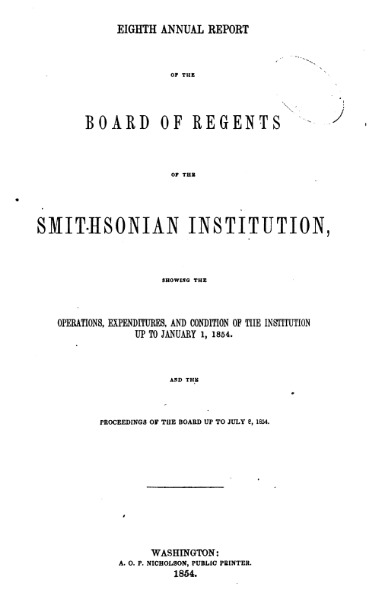

"Every city has its library, so has almost every village, and so have a large number of our common schools. Familiar as this fact is to many of us, it presents a new phase of society, and one indicative of mighty influences. The library is the necessary complement of the school. To teach children to read, and then to give them nothing to supply the desire awakened, is mockery."
The Eighth Annual Report of the Board of Regents of the Smithsonian Institution gives an account of the operations, expenditures, and the condition of the Institute up to the time of this publication in 1854, as well as the previous annual reports going back to the founding of the Institution and the will of its benefactor, James Smithson.
The report of the Assistant Secretary in charge of the Library, Charles C. Jewett, reports the additions to and total numbers of the collections of the Smithsonian Institution Library in 1854. Jewett emphasizes the value of the exchange and donation of material, as opposed to purchasing items. He also reports to the Board the nation-wide need for libraries, and proposes one central, "voluntary yet harmonious" library system.
Smithsonian Institution. Board of Regents., Smithsonian Institution., United States National Museum. (1965). Annual report of the Board of Regents of the Smithsonian Institution. Washington: Smithsonian Institution. Full text available on HathiTrust
#govpubs#1850s#1854#Smithsonian#Library#science#museum#Charles Jewett#Joseph Henry#Linn Boyd#Roger Taney#James Smithson
11 notes
·
View notes
Text

"The original "Uncle Tom",
Rev. Josiah Henson and wife; Dresden ,Canada (c1907)
Josiah Henson (June 15, 1789 – May 5, 1883) was an author, abolitionist, and minister. Born into slavery in Charles County, Maryland, he escaped to Upper Canada (now Ontario) in 1830, and founded a settlement and laborer's school for other fugitive slaves at Dawn, near Dresden in Kent County. Henson's autobiography, The Life of Josiah Henson, Formerly a Slave, Now an Inhabitant of Canada, as Narrated by Himself (1849), is widely believed to have inspired the character of the fugitive slave, George Harris, in Harriet Beecher Stowe's Uncle Tom's Cabin (1852), who returned to Kentucky for his wife and escaped across the Ohio River, eventually to Canada. Following the success of Stowe's novel, Henson issued an expanded version of his memoir in 1858, Truth Stranger Than Fiction. Father Henson's Story of His Own Life (published Boston: John P. Jewett & Company, 1858). Interest in his life continued, and nearly two decades later, his life story was updated and published as Uncle Tom's Story of His Life: An Autobiography of the Rev. Josiah Henson (1876).
Josiah Henson was born on a farm near Port Tobacco in Charles County, Maryland. When he was a boy, his father was punished for standing up to a slave owner, receiving one hundred lashes and having his right ear nailed to the whipping-post, and then cut off. His father was later sold to someone in Alabama. Following his family's master's death, young Josiah was separated from his mother, brothers, and sisters.His mother pleaded with her new owner Isaac Riley, Riley agreed to buy back Henson so she could at least have her youngest child with her; on condition he would work in the fields. Riley would not regret his decision, for Henson rose in his owners' esteem, and was eventually entrusted as the supervisor of his master's farm, located in Montgomery County, Maryland (in what is now North Bethesda). In 1825, Mr. Riley fell onto economic hardship and was sued by a brother in law. Desperate, he begged Henson (with tears in his eyes) to promise to help him. Duty bound, Henson agreed. Mr. R then told him that he needed to take his 18 slaves to his brother in Kentucky by foot. They arrived in Daviess County Kentucky in the middle of April 1825 at the plantation of Mr. Amos Riley. In September 1828 Henson returned to Maryland in an attempt to buy his freedom from Issac Riley.
He tried to buy his freedom by giving his master $350 which he had saved up, and a note promising a further $100. Originally Henson only needed to pay the extra $100 by note, Mr. Riley however, added an extra zero to the paper and changed the fee to $1000. Cheated of his money, Henson returned to Kentucky and then escaped to Kent County, U.C., in 1830, after learning he might be sold again. There he founded a settlement and laborer's school for other fugitive slaves at Dawn, Upper Canada. Henson crossed into Upper Canada via the Niagara River, with his wife Nancy and their four children. Upper Canada had become a refuge for slaves from the United States after 1793, when Lieutenant-Governor John Graves Simcoe passed "An Act to prevent further introduction of Slaves, and to limit the Term of Contracts for Servitude within this Province". The legislation did not immediately end slavery in the colony, but it did prevent the importation of slaves, meaning that any U.S. slave who set foot in what would eventually become Ontario, was free. By the time Henson arrived, others had already made Upper Canada home, including African Loyalists from the American Revolution, and refugees from the War of 1812.
Henson first worked farms near Fort Erie, then Waterloo, moving with friends to Colchester by 1834 to set up a African settlement on rented land. Through contacts and financial assistance there, he was able to purchase 200 acres (0.81 km2) in Dawn Township, in next-door Kent County, to realize his vision of a self-sufficient community. The Dawn Settlement eventually prospered, reaching a population of 500 at its height, and exporting black walnut lumber to the United States and Britain. Henson purchased an additional 200 acres (0.81 km2) next to the Settlement, where his family lived. Henson also became an active Methodist preacher, and spoke as an abolitionist on routes between Tennessee and Ontario. He also served in the Canadian army as a military officer, having led a African militia unit in the Rebellion of 1837. Though many residents of the Dawn Settlement returned to the United States after slavery was abolished there, Henson and his wife continued to live in Dawn for the rest of their lives. Henson died at the age of 93 in Dresden, on May 5, 1883.
#Josiah Henson#Dresden#uncle tom#original uncle tom#american revolution#dawn township#kent county#methodist#preacher#tennessee#ontario#rebellion#dawn settlement#john graves simcoe#province#slaves#united states of america#united states#war of 1812#african#kemetic dreams#afrakan#africans#brownskin#afrakans#brown skin
74 notes
·
View notes
Photo

Born on the 6th of February, 1908, in Port Albot, Wales, Peg Entwistle would come to symbolize everything dark about the chew you up and spit you out Hollywood of the 1930s. Her name and story symbolize the failed dreams of many hopefuls that rushed to Los Angeles in search of stardom.
Entwistle came to the United States with her father following her mother’s death in 1910. Her father was offered a position as a stage manager by Broadway producer, Charles Frohman. Her father tragically passed away in 1922 from injuries sustained in a hit-and-run accident and Entwistle was adopted by her uncle, actor Charles Entwistle. Much like her uncle, Entwistle discovered a love for acting. She studied at Henry Jewett’s Respertory in Boston. While here, her performance as Hedvig in Henrik Ibsen’s “The Wild Duck” was said to have inspired Bette Davis to become an actress.1 After her studies, she was recruited to join the New York Theater Guild where she worked steadily on Broadway.
Despite her success in New York, Entwistle wanted more than to be on stage; she wanted to be on the big screen. Like many before her during the Golden Era, the bright lights of Hollywood lured her in.
She travelled to Hollywood in April of 1932 move into the Hollywood Studio Club, a rooming hotel for women. Later, she moved in with her Uncle Harold at Beachwood Canyon Drive in Hollywood to save money. She got various small parts here and there but she struggled to set herself apart from the plethora of other hopeful actresses and the sea of beautiful faces.
When she finally scored a deal with the prestigious studio, RKO, she was over the moon. It was her big break, she had hoped, but she would soon come to find that she was going to be sadly mistaken....
𝐑𝐞𝐚𝐝 𝐌𝐨𝐫𝐞:
https://morbidology.com/the-hollywood-death-of-peg-entwistle/
37 notes
·
View notes
Text

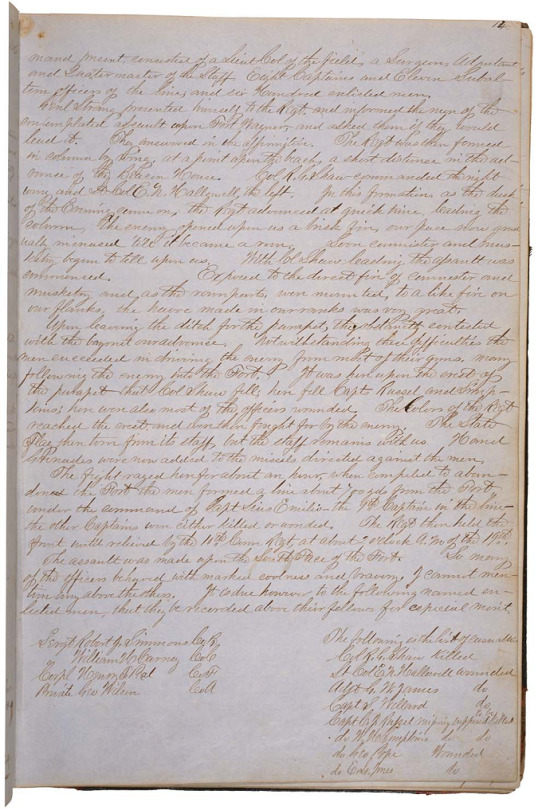

Letter from Colonel Edward Hallowell to General Truman Seymour
Record Group 94: Records of the Adjutant General's OfficeSeries: Regimental and Company Books of Civil War Volunteer Union OrganizationsFile Unit: Regimental and Company Books of the 54th Massachusetts Infantry Regiment (Colored)
This item is a copy of a letter sent by Colonel Edward N. Hallowell to General Truman Seymour concerning the assault on Fort Wagner, South Carolina. It is located in the volume of letters sent by the 54th Regiment of Massachusetts Infantry.
[page number] 13 Head Quarters 54th Regt Mass Vols Morris Island S. C. Nov 7th 1863 To His Excellency John A. Andrew Governor. As yet no official information has been received in regard to the fate of Capts Russel and Simpkins, and we are obliged to drop their names from the rolls. Therefore respectfully suggest the following promotions and appointments. Major Henry W. Hooper. To be Lt. Col. vice E. W. Hallowell promoted Capt George Pope to be Major vice H. W. Hooper promoted 1st Lieut James L. Higgman to be Captain vice C. J. Russel missing in action since July 18th 1863 1st Lieut R. H. L. Jewelt to be Captain vice W. H. Simpkins missing in action since July 18th 1863 1st Lieut James W. Grace to be Captain vice George Pope promoted 2d Lieut David Reid to be 1st Lieut vice J. L. Higgman promoted 2d Lieut Edward B Enurein to be 1st Lieut vice R. H. L. Jewett promoted 2d Lieut Ezekiel Gaulbert Tomlinson to be 1st Lieut. vice James W. Grace, promoted Sergt Daniel G. Spears of 24th Regt Mass to be 2d Lieut, vice David Reid promoted Charles W Duren of 24th Mass to be 2d Lieut vice E. B. Emerson promoted Commission for Mr Dunn to be sent to care of Brig Genl T. G. Stevenson I prefer not to make any other appointments until I learn more of the character of the applicants Very Respectfully E. W. Hallowell Col 54th Mass Vols Head Quarters 54th Mass Vols Morris Island S. C. Nov 7th 1863 Brig Genl. T. Seymour Comd'g U. S. Forces Morris S. C. Genl, In answer to your request that I furnish a report of the part taken by the 54th Mass Vols in the late assault upon Fort Wagner, I have to state, During the afternoon of the 18th of July last the 54th Mass Vols Col R. G. Shaw commanding landed upon Morris Island and reported at about 6 o'clock P.M. to Brig Genl. G. C. Strong. Col Shaw's com- [command][page number] 14 mmand [command] present, consisted of a Lieut Col of the field, a Surgeon, Adjutant, and Quartermaster of the Staff. Eight Captains and Eleven Subaltern officers of the line, and six Hundred enlisted men. Genl Strong presented himself to the Regt and informed the men of the contemplated assault upon Fort Wagner, and asked them if they would lead it. They answered in the affirmative. The Regt was then formed in column by wing, at a point upon the beach, a short distance in the advance of the Beacon House. Col R. G. Shaw commanded the right wing and Lt. Col. W. W. Hallowell the left. In this formation, as the dusk of the Evening came on, the Regt advanced at quick time, leading the column, the enemy opened upon us a brisk fire, our pace now gradually increased 'till it became a run. Soon cannister and musketry began to tell upon us. With Col Shaw leading, the assault was commenced. Exposed to the direct fire of cannister and musketry and as the ramparts, were mounted, to a like fire on our flanks, the havoc made in our ranks was very great. Upon leaving the ditch for the parapet, they obstanitly [obstinately] contested with the bayonet our advance. Notwithstanding these difficulties the men succeeded in driving the enemy from most of their guns, many following the enemy into the Fort. It was here upon the crest of the parapet that Col Shaw fell; here fell Capts Russel and Simpkins; here were also most of the officers wounded. The Colors of the Regt reached the crest and were then fought for by the enemy. The State Flag then torn from its staff, but the staff remains with us. Hand Grenades were now added to the missels [missiles] directed against the men. The fight raged here for about an hour, when compeled [compelled] to abandon the Fort the men formed a line about 700 yds from the Fort under the command of Capt Luis Emilio, the 9th Captain in the line, the other Captains were either killed or wounded. The Regt then held the front until relieved by the 10th Conn Regt, at about 2 o'clock A. M. of the 19th. The assault was made upon the South Face of the Fort. [full transcript at link]
#archivesgov#November 7#1863#Civil War#Fort Wagner#54th Massachusetts#african america history#19th century
19 notes
·
View notes
Text
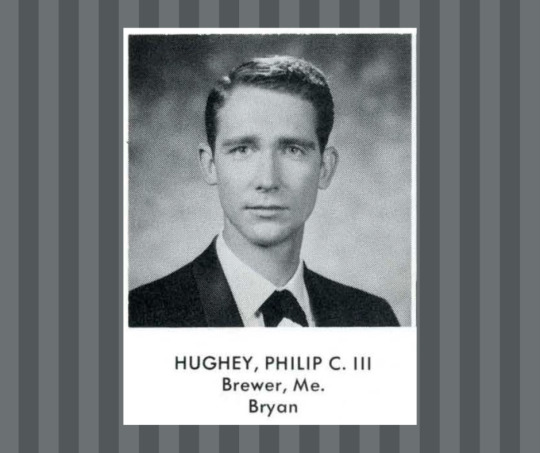
Philip Calvin Hughey III, born on April 4, 1944, in Manhattan, New York, passed away on November 30, 2023 in Manchester, New Hampshire. He was the cherished son of Rev. Philip C. Hughey Jr. and Alberta Wray (Daniels) Hughey.
Phil's journey was one marked by unwavering service and faith. On October 19, 1968, he married Marilyn (Francis) Hughey, in Rantoul, Illinois, beginning a loving partnership that spanned over five decades. A graduate of Bob Jones University in 1968 with a Bachelor of Arts in music, Phil's passion for music became a cornerstone of his identity. Following his academic pursuits, he served with honor in the United States Air Force for four years as a staff sergeant, specializing in jet mechanics. Phil's spiritual journey led him to serve as Assistant Pastor at First Baptist Church in Caribou, Maine, and later in East Longmeadow, Massachusetts. His guidance and compassion provided comfort to those who sought solace within the congregation.
A pivotal chapter in Phil's life began when he became the director of the Boylston Home for Girls in Manchester, New Hampshire. His encouragement and support left a lasting impact on the lives of the young women under his care. Phil concluded his professional journey with tenure at the Manchester Health Department, where he became affectionately known as "Mr. Phil." His service to public health showcased his commitment to the well-being of the community.
Phil was a long-time member of Southside Bible Fellowship Church in Manchester. His musical talents contributed to the worship team as he played the organ and piano. Phil's dedication extended to teaching Sunday school, volunteering with AWANA clubs, and serving as a church community Elder. Phil is survived by his wife Marilyn; his children, Jennings Alys (Hughey) Loftus and husband Timothy, Daniel Philip and wife Kathleen (Wall) Hughey, and Sarah Elizabeth (Hughey) Kruse and husband Klaus. He adored his grandchildren, Savana and Morgen Hughey, Jace Loftus, Matilda, Magdelena, and Charles Kruse. Phil is also survived by his sisters, Berta and her husband Erwin Merill, Sue Hughey, Ruth and her husband Gary Venidestine, brother Paul Hughey and his wife Lori, sister-in-law Carolyn and her husband Lyman Johnson, as well as many nieces and nephews. Phil's legacy of love, faith, and service will forever be etched in the hearts of those who were fortunate enough to know him.
A celebration of Phil's life service for friends and family will be held at South Side Bible Fellowship on 09 December 2023 at 1pm. Located a 200 South Jewett St., Manchester, NH 03103. In lieu of flowers, the family requests that donations be made to Southside Bible Fellowship Deacon Fund in Phil's honor. May he rest in peace, and may his memory be a source of comfort and inspiration to us all.
#Bob Jones University#BJU Hall of Fame#2023#Obituary#BJU Alumni Association#Class of 1968#Philip Calvin Hughey III
0 notes
Note
Literally not an anon, you can see I'm a logged in user? But, from "The Disappearing Spoon" by Sam Kean:
"Because of its luster, mineralogists immediately classified aluminium as a precious metal, like silver or platinum, worth hundreds of dollars an ounce. [...] At Oberlin College in Ohio, a chemistry professor named Frank Fanning Jewett would regale his students with tales of the aluminium El Dorado that awaited whoever mastered this element." (note: this man was Charles Hall who is co-credited with the crash of the aluminum market alongside Paul Heroult in France) "When chemists in the early 1800s speculated about the existence of element thirteen, they used both spellings but eventually settled on the extra i. That spelling paralleled the recently discovered bariym, magnesium, sodium, and strontium. When Charles Hall applied for patents in his electric current process, he used the extra i, too. However, when advertising his shiny metal, Hall was looser with his language. [...], but when Hall saw "aluminum," he thought it a brilliant coinage. He dropped the vowel permanently, and with it a syllable, which aligned his priduct with classy platinum. His new metal caught on so quickly and grew so economically important that 'aluminum' became incredibly stamped on the American psyche." (Excerpts are from pages 234 to 237)
Anti-aluminum propaganda: we, as in the US, thought it was a precious metal (hece why we spell it differently - it's supposed to mimic platinum) and then one guy tried to get rich out from finding an abundant source of it, but he Messed Up when handling the discovery and tanked the price of aluminum so much that now it's an everyday product and we've learned its THE most abundant metal on earth
lmao fail
47 notes
·
View notes
Photo


The Redemption of David Corson by Charles Frederic Goss
Boardwalk Empire: "A Man, a Plan…"
3 notes
·
View notes
Text
"Seeding by Ceding": MacKenzie Scott Donates $2.7 Billion to Racial Justice Organizations, Arts Groups and Community-Based Non-Profits
“Seeding by Ceding”: MacKenzie Scott Donates $2.7 Billion to Racial Justice Organizations, Arts Groups and Community-Based Non-Profits
by Lori Lakin Hutcherson (@lakinhutcherson) MacKenzie Scott, novelist, former teacher and ex-wife of Amazon founder and CEO Jeff Bezos, is a real one. Scott’s net worth since her divorce settlement from Bezos stands close to $60 billion, and Scott has vowed to give away her wealth in her lifetime -“until the safe is empty” – because she believes “it would be better if disproportionate wealth were…

View On WordPress
#"Seeding by Ceding"#Alternate ROOTS#Alvin Ailey American Dance Theater#Amazon#Charles H. Wright Museum of African American History#Dan Jewett#Jeff Bezos#MacKenzie Scott#Medium#philanthropy#Women&039;s Funding Network
12 notes
·
View notes
Photo

John Charles Frémont, William Smith Jewett, Smithsonian: National Portrait Gallery
Size: 37.8 x 28cm (14 7/8 x 11") Medium: Oil on canvas
https://npg.si.edu/object/npg_NPG.72.17
2 notes
·
View notes
Text

Hello, everyone!
I kept a list in 2019 of everything I read and I thought it would be fun to share it here! If you have any questions about any of the texts listed below, or if you’ve read any of them before and want to discuss them, please send me an ask/message. I would love to start a conversation about literature here!
Key: <short story, ~children’s book, *play, anything I had read before
~the wind in the willows // kenneth grahame
<hunters in the snow // tobias wolff
<how i met my husband // alice munro
<a worn path // eudora welty
<there will come soft rains // ray bradbury
~charlotte’s web // e.b. white
~alice’s adventures in wonderland // lewis carroll
~the wonderful wizard of oz // l. frank baum
~james and the giant peach // roald dahl
<a family // jamel brinkley
<boys go to jupiter // danielle evans
<a history of china // carolyn ferrell
<what got into us // jacob guajardo
<everything is far from here // cristina henriquez
<the brothers brujo // matthew lyons
<a big true // dina nayeri
<suburbia! // amy silverberg
<the prairie wife // curis sittenfeld
<somnambulism: a fragment // charles brockden brown
<the fall of the house of usher // edgar allan poe
<my visitation // rose terry cooke
<circumstance // harriet prescott spofford
<a whisper in the dark // louisa may alcott
moby dick // herman melville
~the phantom tollbooth // horton juster
~harriet the spy // louise fitzhugh
~dear mr. henshaw // beverly cleary
~bud, not buddy // christopher paul curtis
~el deafo // cece bell
<the foreigner // sarah orne jewett
<at the hermitage // e. levi brown
<the little room // madeline yale wynne
<desiree’s baby // kate chopin
<the yellow wall-paper // charlotte perkins gilman
<the house that was not // elia wilkinson peattie
<the eyes // edith wharton
the way of kings // brandon sanderson
the sun also rises // ernest hemingway
*angels in america // tony kushner
nature poem // tommy pico
under the feet of jesus // helena viramontes
*the taming of the shrew // shakespeare
*a midsummer night’s dream // shakespeare
heart of darkness // joseph conrad
*othello // shakespeare
*romeo and juliet // shakespeare
*sir thomas more // shakespeare, et al
*twelfth night // shakespeare
*the merchant of venice // shakespeare
*hamlet // shakespeare
<sanctuary // nella larsen
the wonderful adventures of mrs. seacole in many lands // mary seacole
kim // rudyard kipling
things fall apart // chinua achebe
<the courter // salman rushdie
<the lion and the jewel // wole soyinka
<a small place // jamaica kincaide
#stephie talks#my edits#mine#literature#classic literature#heyrosiebee#heyindia#lookqueenie#mariecuriestudies#bookssweatandtears
20 notes
·
View notes
Text
19th Century Trolling
The Moral ‘Suasion (1842)
2.0 oz.- Peach Brandy
2.0 tsp.- Cognac
1.0 tsp.- Curaçao
1.0 tsp.- Sugar
0.5 oz.- Benedictine
0.5 oz.- Lemon Juice
Before Prohibition people who wanted alcohol outlawed for being the root of evil in our country openly clashed and argued with people who appreciated the ability to imbibe as they pleased.
Back before people got their news from platforms like Snapchatthey…
View On WordPress
#Alcohol History#Benedictine#BFD#Booze Fact of the Day#Brandy#Charles Jewett#cocktail#Cocktail History#Cognac#Lemon#Moral &039;Suasion#Newspaper#Peter Brigham#Snapchat#Sugar#Troll#Trolling
0 notes
Photo
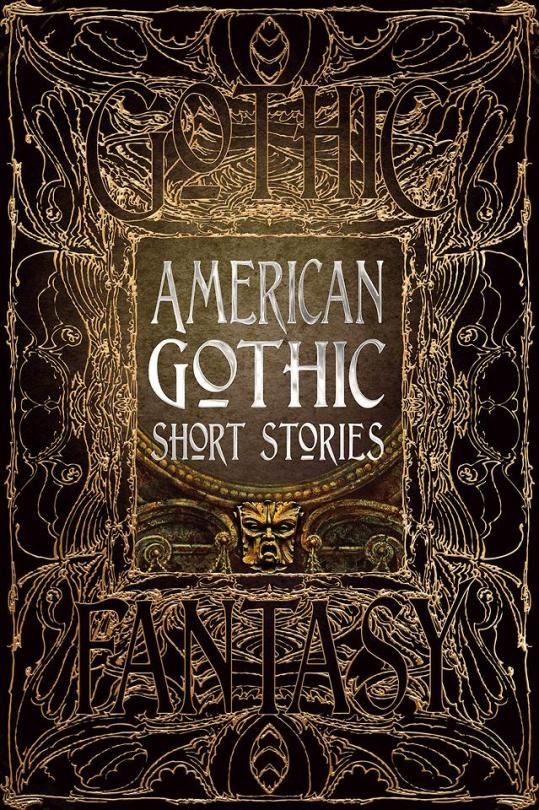
American Gothic Short Stories, edited by Monika Elbert, Flame Tree Publishing, 2019. Info: flametreepublishing.com.
With handsome young men who never grow old, and the strangest of relatives appearing from dark corridors and long shadows, the frenzied imagination of the American Gothic is a fertile theme for this next anthology in the Gothic fantasy short story series. As with other titles in the series, new short fiction complements the work of classic authors.
Featuring: Foreword by Monika Elbert “Stone Baby” by Terri Bruce “The Tomb-Herd” by Ramsey Campbell “The Dark Presser” by E.E.W. Christman “Graveyards Full” by Maxx Fidalgo “Old Homeplace” by Joshua Hiles “In the Domain of Doctor Baldwin” by Russell James “Baby Girl” by Clayton Kroh “Viola’s Second Husband” by Sean Logan “The Outsiders in the Hawthorne Tomb” by Madison McSweeney “Big, Bad” by Lynette Mejía “Gothic American” by Joe Nazare “In the Bleak” by Wendy Nikel “In the Country” by Christi Nogle “Baby Teeth” by Lina Rather “Bibliosmia” by M. Regan “Water Witch” by Rebecca Ring “Ring of Teeth” by Mike Robinson “Approaching Lavender” by Lucy A. Snyder “Amazing Patsy” by Valerie B. Williams “The Hollow Tree” by Nemma Wollenfang
These contemporary authors will appear alongside the following classic and essential writers: Gertrude Atherton, Ambrose Bierce, Charles Brockden Brown, George Washington Cable, Charles W. Chesnutt, Kate Chopin, Ralph Adams Cram, Stephen Crane, Emma Dawson, Mary E. Wilkins Freeman, Charlotte Perkins Gilman, Ellen Glasgow, Nathaniel Hawthorne, Washington Irving, Shirley Jackson, Sarah Orne Jewett, Grace King, H.P. Lovecraft, Herman Melville, W.C. Morrow, Flannery O'Connor, Edgar Allan Poe, Annie Trumbull Slosson, Clark Ashton Smith, Harriet Prescott Spofford, Harriet Beecher Stowe, Edith Wharton, Madeline Yale Wynne.
#book#anthology#weird fiction#gothic#modern gothic#horror fiction#dark fiction#american gothic#gothic fantasy#supernatural fiction
12 notes
·
View notes
Photo

Erie County Free Week continues through February 23! All @eriecountyny residents receive FREE admission. Don't miss your chance to explore "Humble and Human: An Exhibition in Honor of Ralph C. Wilson, Jr.," an exhibition of Impressionist and post-Impressionist treasures from the Albright-Knox and @diadetroit. [Visitors in "Humble and Human" with Willard Leroy Metcalf’s “Pelago—Tuscany,” 1913 (Collection Albright-Knox Art Gallery, Sherman S. Jewett Fund, 1917) and “The White Veil,” 1909 (Collection Detroit Institute of Arts, Gift of Charles Willis Ward, 15.12), and Childe Hassam’s “Church at Old Lyme, Connecticut,” 1905 (Collection Albright-Knox Art Gallery, Albert H. Tracy Fund, 1909). 📷 Mark Why] #AlbrightKnox #art #museum #artmuseum #buffalo #buffalony #humbleandhuman http://bit.ly/2T4yeGi
2 notes
·
View notes
Text
New Fiction 2022 - October
Short Stories & Chapters
"Leonora" by Everil Worrell (1927)
"The Hollow Man" by Norman Partridge (1991)
"The Black Stone Statue" by Mary Elizabeth Counselman (1937)
"The Door" by Ann R. Loverock (2020)
"The Events at Poroth Farm" by T.E.D. Klein (1972)
"The Dead Wagon" by Greye La Spina (1927)
"Soft" by F. Paul Wilson (1984)
"Beelzebub" by Robert Bloch (1963)
"The Black Phone" by Joe Hill (2004)
"The Angle of Horror" by Cristina Fernández Cubas (1996)
"The Striding Place" by Gertrude Atherton (1896)
"The Fall of the House of Usher" by Edgar Allan Poe (1839)
"The Nurse's Story" by Elizabeth Gaskell (1852)
"The Girl With the Hungry Eyes" by Fritz Leiber (1949)
"The Summer People" by Shirley Jackson (1950)
"The Husband Stitch" by Carmen Maria Machado (2014)
"The Phantom 'Rickshaw" by Rudyard Kipling (1888)
"Scales" by Cherene Sherrard (2017)
"The Aztec" by Carmen Baca (2020)
"The Reaper's Image" by Stephen King (1969)
"The Mummy’s Foot" by Théophile Gautier (1840)
"When the Gentlemen Go By" by Margaret Ronald (2008)
"The Pear-Shaped Man" by George R.R. Martin (1987)
"Turn Out the Light" by Penelope Love (2015)
"Unseen—Unfeared" by Francis Stevens (1919)
"The White Cormorant" by Frithjof Spalder (1971)
"A Ghost Story" by Mark Twain (1870)
"The Signal-Man" by Charles Dickens (1866)
"Rearview" by Samantha Hunt (2020)
"The Green Bowl" by Sarah Orne Jewett (1901)
"A Good Student" by Nuzo Onoh (2014)
Dracula Daily - "October" by Bram Stoker & ed. Matt Kirkland (1897, 2021)
Comic Shorts & Single Issues
"Swamp Monster" by Basil Wolverton (1953)
"The Portrait of Sal Pullman" by Lonnie Nadler & Abby Howard (2019)
"O Whistle, and I'll Come to You, My Lad" by M.R. James & Abby Howard (2019)
"Rainbow Sprinkles" by W. Maxwell Prince, Chris O’Halloran, Martín Morazzo, Nimit Malavia (2018)
"Mirror, Mirror, on the Wall!" by Jack Davis, et al. (1953)
"The Harvest" by Shannon Campbell & Pam Wishbow (2016)
"In Each and Every Package" by Reed Crandall, et al. (1954)
"Roots in Hell" by Richard Corben (2016)
"Mars Is Heaven!" by Ray Bradbury, Wally Wood, et al. (1953)
"Save the Last Dance for Me!" by Dennis O'Neil & Pat Boyette (1969)
"Infected" by Bruce Jones, Richard Corben, Steve Oliff (1982)
"Unpleasant Side Effects" by Kerry Gammill, Sam F. Park, Mar Omega (2010)
"The Boar's Head Beast" by George Wildman, Nicola Cuti, Wayne Howard (1975)
"Ill Bred" by Charles Burns (1985)
"Don't Go to the Island" by Sfé R. Monster & Kalyna Riis-Phillips (2016)
"Some Other Animal's Meat" by Emily Carroll (2016)
"Greed" by Becky Cloonan, Jordie Bellaire, Travis Lanham (2013)
"Goin' South" by Nancy Collins, David Imhoff, Jeff Butler, Steve Montano, Renée Witterstaetter, Electric Crayon, Simon Bisley (1995)
"Winnebago Graveyard #1" by Steve Niles, Stephanie Paitreau, Jordie Bellaire, Jen Bartel, Alison Sampson, Aditya Bidikar, Mingjue Helen Chen, Sarah Horrocks (2017)
"Seed" by Fiona Staples, Jose Villarrubia, Michael Dougherty, Todd Casey, Zach Shields, Marc Andreyko (2015)
"Kill Screen" by Lauren Beukes, Dale Halvorsen, Ryan Kelly, Eva de la Cruz, Clem Robins, Bill Sienkiewicz, Rowena Yow, Shelly Bond (2015)
"The Fool of the Web" by Patricia Breen, Roel, Brenda Feikema (1997)
"Fortune Broken" by Sandy King, Leonardo Manco, Marianna Sanzone (2015)
"The Cemetery" by Franco, Abigail Larson, Wes Abbott, Sara Richard (2022)
"The Speed of Pain" by Jeff Lemire, Andrea Sorrentino, Dave Stewart, Steve Wands, Will Dennis (2018)
"Gestation" by Marguerite Bennett, Jonathan Brandon Sawyer, Doug Garbark, Nic. J. Shaw (2014)
"Chemical 13!" by Michael Woods & Saskia Gutekunst (2009)
"Hello, My Name Is..." by Nadia Shammas, Rowan MacColl, Licha Myers, Chris Sanchez (2021)
"Sea of Souls" by Jenna Lynn Wright, Alvaro Feliu, Juan Francisco Mota, Ricardo Osnaya, Erik Lopera Tamayo, Jorge Cortes, Robby Bevaro, Maxflan Araujo, Walter Pereyra, Taylor Esposito (2022)
"Crush" by Janet Hetherington, Ronn Sutton, Becka Kinzie, Zakk Saam (2018)
"The End of All Things" by Natalie Leif & Elaine Well (2014)
Video & Electronic Games
Silent Hill dev. Team Silent (1999)
The Excavation of Hob's Barrow dev. Cloak and Dagger Games (2022)
Halloween Forever dev. Imaginary Monsters (2016)
Bride of Frankenstein dev. Paul Smith, Steve Howard, Timedata Ltd. (1987)
Zombies Ate My Neighbors dev. LucasArts (1993)
Darkstalkers 3 (aka Vampire Savior) dev. Capcom (1997)
Movies
Smile dir. Parker Finn (2022)
The Mummy dir. Karl Freund (1932)
Invasion of the Body Snatchers dir. Don Siegel (1956)
The Skin I Live In dir. Pedro Almodóvar (2011)
The Picture of Dorian Gray dir. Albert Lewin (1945)
The Uninvited dir. Lewis Allen (1944)
The Other Side of the Underneath dir. Jane Arden (1972)
Jeepers Creepers: Reborn dir. Timo Vuorensola (2022)
Terrifier 2 dir. Damien Leone (2022)
Ravenous dir. Antonia Bird (1999)
The Experiment dir. Oliver Hirschbiegel (2001)
Ganja & Hess dir. Bill Gunn (1973)
Def by Temptation dir. James Bond III (1990)
Eyes Without a Face dir. Georges Franju (1960)
Under the Shadow dir. Babak Anvari (2016)
Amsterdam dir. David O. Russell (2022)
Deadstream dir. Joseph Winter & Vanessa Winter (2022)
In My Skin by Marina de Van (2002)
Evolution dir. Lucile Hadžihalilović (2015)
Eko Eko Azarak: Wizard of Darkness dir. Shimako Satō (1995)
Celia dir. Ann Turner (1989)
Censor dir. Prano Bailey-Bond (2021)
Halloween Ends dir. David Gordon Green (2022)
The Cabinet of Dr. Caligari dir. Robert Wiene (1920)
Black Adam dir. Jaume Collet-Serra (2022)
Trouble Every Day dir. Claire Denis (2001)
Eve's Bayou dir. Kasi Lemmons (1997)
Monster (aka Humanoids from the Deep) dir. Barbara Peeters & Jimmy T. Murakami (1980)
The Mafu Cage dir. Karen Arthur (1978)
Medusa: Queen of the Serpents dir. Matthew B.C. (2020)
Medusa dir. Anita Rocha da Silveira (2021)
Prey for the Devil dir. Daniel Stamm (2022)
It Follows dir. David Robert Mitchell (2014)
Amer dir. Hélène Cattet & Bruno Forzani (2009)
TV Episodes
The Simpsons - "Treehouse of Horror XXXIII" (2022)
Bob's Burgers - "Apple Gore-chard! (But Not Gory)" (2022)
TV Series
Costume Quest (2019)
Castlevania - Seasons 3 & 4 (2020-2021)
1 note
·
View note
Photo
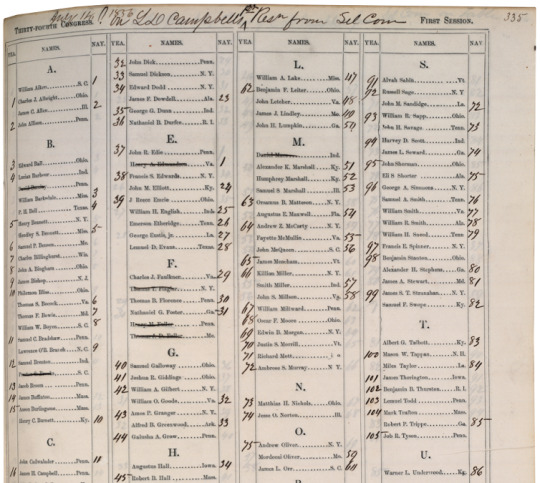
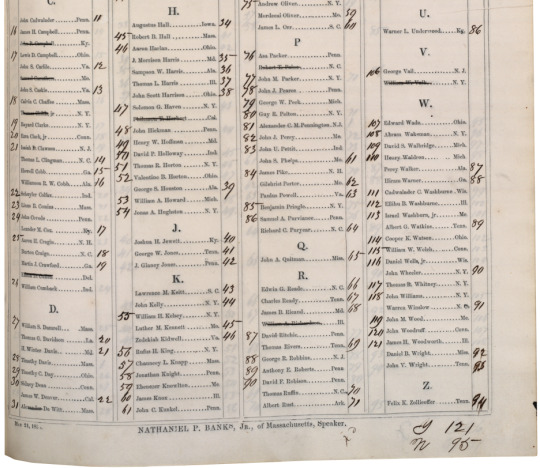
Roll Call Tally on the Expulsion of Preston Brooks, 7/14/1856
After Preston Brooks beat Charles Sumner nearly to death with a cane in the Senate chamber, the House voted on whether to expel him from Congress. They failed to reach the two-thirds majority needed.
Series: General Records, 1791 - 2010
Record Group 233: Records of the U.S. House of Representatives, 1789 - 2015
Transcription:
July 14. 1856
On LD Campbells 1st Resn from Sel Com
THIRTY-FOURTH CONGRESS
FIRST SESSION
335
[column one]
YEA | NAMES. | NAY.
A.
|William Aiken...S.C. | 1
1 | Charles J. Albright...Ohio. |
| James C. Allen...Ill. | 2
2| John Allison...Penn. |
B.
3 | Edward Ball...Ohio |
4 | Lucian Barbour...Ind. |
|David Barclay [struck through] |
| William Barksdale...Miss. | 3
| P.H. Bell...Texas. | 4
5 | Henry Bennett...N.Y. |
| Hendley S. Bennett...Miss. | 5
6 | Samuel P. Benson...Me. |
7 | Charles Billinghurst...Wis |
8 | John A. Bingham...Ohio |
9 | James Bishop...N.J. |
10 | Philemon Bliss...Ohio |
| Thomas S. Bocock...Va. | 6
| Thomas F. Bowie...Md. | 7
| William W. Boyce...S.C. | 8
11 | Samuel C. Bradshaw...Penn. |
| Lawrence O'B. Braneh...N.C. | 9
12 | Samuel Brenton...Ind. |
| Preston S. Brooks [struck through]...S.C. |
13 | Jacob Broom...Penn. |
14 | James Buffinton...Mass. |
15 | Anson Burlingame...Mass. |
| Henry C. Burnett...Ky. | 10
C.
| John Cadwalader...Penn. | 11
16 | James H. Campbell...Penn. |
|John P. Campbell [struck through]...Ky. |
17 | Lewis D. Campbell...Ohio |
| John S. Carlile...Va. | 12
| Samuel Caruthers [struck through]...Mo. |
| John S. Caskie...Va. | 13
18 | Calvin C. Chaffee...Mass. |
| Thomas Child, jr [struck through] ...N.Y. |
19 | Bayard Clarke...N.Y. |
20 | Ezra Clark, jr...Conn. |
21 | Isaiah D. Clawson...N.J. |
| Thomas L. Clingman...N.C. | 14
| Howell Cobb...Ga. | 15
| Williamson R.W. Cobb...Ala. | 16
22 | Schuyler Colfax...Ind. |
23 | Linus B. Comins...Mass. |
24 | John Covode...Penn. |
| Leander M. Cox...Ky. | 17
25 | Aaron H. Cragin...N.H. |
| Burton Craige...N.C. | 18
| Martin J. Crawford...Ga. | 19
| Elisha D. Cullen [struck through]...Del. |
26 | William Cumback...Ind. |
D.
27 | William S. Damrell...Mass. |
| Thomas G. Davidson...La. | 20
| H. Winter Davis...Md. | 21
28 | Timothy Davis...Mass. |
29 | Timothy C. Day...Ohio. |
30 | Sidney Dean...Conn. |
| James W. Denver...Cal. | 22
31| Ale["xander" struck through] De Witt...Mass. |
[Column Two]
YEA. | NAMES. | NAY.
32 | John Dick...Penn. |
33 | Samuel Dickson...N.Y. |
34 | Edward Dodd...N.Y. |
| James F. Dowdell...Ala. | 23
35 | George G. Dunn...Ind. |
36 | Nathaniel B. Durfee...R.I. |
E.
37 | John R. Edie...Penn. |
| Henry A. Edmundson [struck through] ...Va. | 1
38 | Francis S. Edwards...N.Y. |
| John M. Elliott...Ky. | 24
39 | J Reece Emrie...Ohio. |
| William H. English...Ind. | 25
| Emerson Etheridge...Tenn. | 26
| George Eustis, jr...La. | 27
| Lemuel D. Evans...Texas. | 28
F.
| Charles J. Faulkner...Va. | 29
| Thomas T. Flagler [struck through]...N.Y. |
| Thomas B. Florence...Penn. | 30
| Nathaniel G. Foster...Ga. | - 31
| Henry M. Fuller [struck through] ...Penn. |
| Thomas J. D. Fuller [struck through] ...Me. |
G.
40 | Samuel Galloway...Ohio. |
41 | Joshua R. Giddings...Ohio. |
42 | William A. Gilbert...N.Y. |
| William O. Goode...Va. | 32
43 | Amos P. Granger...N.Y. |
| Alfred B. Greenwood...Ark. | 33
44 | Galusha A. Grow...Penn. |
H.
| Augustus Hall...Iowa. | 34
45 | Robert B. Hall...Mass |
46 | Aaron Harlan...Ohio. |
| J. Morrison Harris...Md. | 35
| Sampson W. Harris...Ala. | 36
| Thomas L. Harris...Ill. | 37
| John Scott Harrison...Ohio. | 38
47 | Solomon G. Haven...N.Y. |
| Philemon T. Herbert...Cal. |
48 | John Hickman...Penn. |
49 | Henry W. Hoffman...Md. |
50 | David P. Holloway...Ind. |
51 | Thomas R. Horton...N.Y. |
52 | Valentine B. Horton...Ohio. |
| George S. Houston...Ala. | 39
53 | William A. Howard...Mich. |
54 | Jonas A. Hughston...N.Y. |
J.
| Joshua H. Jewett...Ky. | 40
| George W. Jones...Tenn. | 41
| J. Glancy Jones...Penn. | 42
K.
| Lawrence M. Keitt...S.C. | 43
| John Kelly...N.Y. | 44
55 | William H. Kelsey...N.Y. |
| Luther M. Kennett...Mo. | 45
| Zedekiah Kidwell...Va. | 46
56 | Rufus H. King...N.Y. |
57 | Chauncey L. Knapp...Mass. |
58 | Jonathan Knight...Penn. |
59 | Ebenezer Knowlton...Me. |
60 | James Knox...Ill. |
61 | John C. Kunkel...Penn. |
[Column Three]
YEA. | NAMES. | NAY.
L.
| William A. Lake...Miss. | 47
62 | Benjamin F. Leiter...Ohio. |
| John Letcher...Va. | 48
| James J. Lindley...Mo. | 49
| John H. Lumpkin...Ga. | 50
M.
| Daniel Mace [struck through] ...Ind. |
| Alexander K. Marshall...Ky. | 51
| Humphrey Marshall...Ky. | 52
| Samuel S Marshall...Ill. | 53
63 | Orsamus B. Matteson...N.Y. |
| Augustus E. Maxwell...Fla. | 54
64 | Andrew Z. McCarty...N.Y. |
| Fayette McMullin...Va. | 55
| John McQueen...S.C. | 56
65 | James Meacham...Vt. |
66 | Killian Miller...N.Y. |
| Smith Miller...Ind. | 57
| John S. Millson...Va. | 58
67 | William Millward...Penn. |
68 | Oscar F. Moore...Ohio. |
69 | Edwin B. Morgan...N.Y. |
70 | Justin S. Morrill...Vt. |
71 | Richard Mott...i o |
72 | Ambrose S. Murray...N.Y. |
N.
73 | Matthias H. Nichols...Ohio |
74 | Jesse O. Norton...Ill. |
O.
75 | Andrew Oliver...N.Y. |
| Mordecai Oliver...Mo. | 59
| James L. Orr...S.C. | 60
P.
76 | Asa Packer...Penn. |
| Robert T. Paine [struck through] ...N.C. |
77 | John M. Parker...N.Y. |
78 | John J. Pearce...Penn. |
79 | George W. Peek...Mich. |
80 | Guy R. Pelton...N.Y. |
81 | Alexander C.M. Pennington. N.J. |
82 | John J. Perry...Me. |
83 | John U. Pettit...Ind. |
| John S. Phelps...Mo. | 61
84 | James Pike...N.H. |
| Gilchrist Porter...Mo. | 62
| Paulus Powell...Va. | 63
85 | Benjamin Pringle...N.Y. |
86 | Samuel A. Purviance...Penn. |
| Richard C. Puryear...N.C. | 64
Q.
| John A. Quitman...Miss. | 65
R.
| Edwin G. Reade...N.C. | 66
| Charles Ready...Tenn. | 67
| James B. Ricaud...Md. | 68
| William A. Richardson [struck through] ...Ill. |
87 | David Ritchie...Penn. |
| Thomas Rivers...Tenn. | 69
88 | George R. Robbins...N.J. |
89 | Anthony E. Roberts...Penn |
90 | David F. Robison...Penn. |
| Thomas Ruffin...N.C. | 70
| Albert Rust...Ark. | 71
[Column Four]
YEA. | NAMES. | NAY.
S.
91 | Alvah Sabin...Vt. |
92 | Russell Sage...N.Y. |
| John M. Sandidge...La. | 72
93 | William R. Sapp...Ohio. |
| John H. Savage...Tenn. | 73
94 | Harvey D. Scott...Ind. |
| James L. Seward...Ga. | 74
95 | John Sherman...Ohio. |
| Eli S Shorter...Ala. | 75
96 | George A. Simmons...N.Y. |
| Samuel A. Smith...Tenn. | 76
| William Smith...Va. | 77
| William R. Smith...Ala. | 78
| William H. Sneed...Tenn. | 79
97 | Francis E. Spinner...N.Y. |
98 | Benjamin Stanton...Ohio. |
| Alexander H. Stephens...Ga. | 80
| James A. Stewart...Md. | 81
99 | James S.T. Stranahan...N.Y. |
| Samuel F. Swope...Ky. | 82
T.
| Albert G. TAlbott...Ky. | 83
100 | Mason W. Tappan...N.H. |
| Miles Taylor...La. | 84
101 | James Thorington...Iowa. |
102 | Benjamin B. Thurston...R.I. |
103 | Lemuel Todd...Penn. |
104 | Mark Trafton...Mass |
| Robert P. Trippe...Ga. | 85
105 | Job R. Tyson...Penn. |
U.
| Warner L. Underwood...Ky. | 86
V.
106 | George Vail...N.J. |
| William W. Valk [struck through] ...N.Y. |
W.
107 | Edward Wade...Ohio. |
108 | Abram Wakeman...N.Y.
109 | David S. Walbridge...Mich. |
110 | Henry Waldron...Mich |
| Percy Walker...Ala. | 87
| Hiram Warner...Ga. | 88
111 | Cadwalader C. Washburne, Wis. |
112 | Ellihu B. Washburne...Ill. |
113 | Israel Washburn, jr...Me. |
| Albert G. Watkins...Tenn. | 89
114 | Cooper K. Watson...Ohio.|
115 | William W. Welch...Conn. |
116 | Daniel Wells, jr...Wis. |
| John Wheeler...N.Y. | 90
117 | Thomas R. Whitney...N.Y. |
118 | John Williams...N.Y. |
| Warren Winslow...N.C. | 91
119 | John M. Wood...Me. |
120 | John Woodruff...Conn. |
121 | James H. Woodworth...Ill. |
| Daniel B. Wright...Miss. | 92
| John V. Wright...Tenn. | 93
Z.
| Felix K. Zollicoffer...Tenn. | 94
[end columns]
MAY 21, 1856
NATHANIEL P. BANKS, JR., of Massachusetts, Speaker.
ex [sideways]
Y 121
N 95
#archivesgov#July 14#1856#1800s#antebellum#slavery#Kansas-Nebraska Act#violence#U.S. Congress#Senate
49 notes
·
View notes
Text
19. The Connecticut River Museum. The old Steamboat Dock in Essex was built in 1878 by Phoebe Hayden, widow of William S. Hayden. Originally a warehouse and general store, the building has been used for various purposes over the years. In 1944, it was acquired by the Lovell family, owners of the nearby Griswold Inn, who put a restaurant on the second floor. The Steam Boat Dock served the Ely-Lyme ferry. After they sold the building in 1962, it began to fall into disrepair, but was eventually saved and converted to become home to the Connecticut River Museum.

Town Dock: Moored at the Town Dock is the a replica of the Onrust, Dutch for “unrest” or “restless” built by Adriaen Block in 1614. Site of Essex Elly’s Ferry to Lyme, CT.

20. Hayden Chandlery. 1813. Captain Richard Hayden‘s Chandlery in Essex was built in 1813 and originally stood at the corner of Main Street and Novelty Lane. Constructed in the Federal style, it served as a chandlery (a store selling supplies and equipment for seamen and ships). Built next to Hayden‘s shipyard, the building continued to be used as ship’s store, although by the early twentieth century the upper floor housed a tenement. The first floor windows and the projecting windows on the second floor are later additions. The building was moved to its present location in 1949 by the then owners of the Griswold Inn and placed on a more modern foundation. The chandlery and nearby steamboat dock warehouse were purchased by the Connecticut River Foundation in 1974, in order to preserve the historic waterfront. Renamed the Connecticut River Museum, the institution restored the chandlery in 1975 to display exhibits. Thomas A. Stevens, a former director of Mystic Seaport, died in 1982 and left his library to the museum. That same year, the warehouse had been converted into a museum building and the chandlery was again renovated, this time to hold the Thomas A. Stevens maritime research library.
21. The Oliver Cromwell ship. On June 13, 1776, the ship Oliver Cromwell, built by Uriah Hayden, was launched in Essex. The ship was one of the largest full-rigged ships built for the state after the establishment of Connecticut’s navy. The Navy was formed after the start of the American Revolutionary War in July of 1775 when the Connecticut General Assembly authorized Governor Jonathan Trumbull and the Council of Safety to purchase and outfit two armed vessels. The General Assembly later authorized the purchase of more ships including the construction of the Oliver Cromwell. All of the ships of the Connecticut Navy were captured or destroyed by 1779. The Oliver Cromwell, in its service to the Navy, captured nine British ships, the first being the brig Honour, before it was itself captured in July 1779 off Sandy Hook by three British ships and a brig after a two-hour battle.
22. Robert Lay House. Built in 1730 on land homesteaded since 1648, it is one of the oldest surviving houses in Essex. The estate was broken up in 1820. It is now owned by the Connecticut River Museum. The Lay wharf was to the North west. Once known as the beehive because of the large number of rented rooms, the house has been restored and is now part of the River museum complex.
23. Commercial building. 53 Main Street. Dates back to 1720, according to Town list.
24. Parking lot. Former site of Old Red Balloon building, Guy C. Wigan’s studio?
25. Thomas Millard Homestead. Thomas, a ship figurehead carver from New York City built this smaller gambrel style house in 1802; it is one of three houses he built on lower Main. Now part of Griswold Inn complex and home to a coffee shop.
26. Timothy Starkey, Jr.’s house, now part of the Griswold Inn complex, was built in 1800, when he leased land from Samuel Lay to build his home on the corner of Main Street and Ferry Street (the latter street being laid out in the 1820s, after the house was constructed). Starkey later bought the land and property extending along Main Street to the wharf, developed Pratt Street and was involved in various business ventures. Timothy Starkey married his cousin, Mary Ann Hayden, a daughter of Uriah Hayden. Starkey owned the Hayden-Starkey Store with his brothers-in-law, Samuel Hayden and Ebenezer Hayden II. Timothy’s brother, Felix Starkey, lived next door to him and married Esther Hayden, who was also a daughter of Uriah Hayden. The house later passed to Timothy’s daughter, Phoebe, who had married William S. Hayden. The house remained in the family until 1974 and is is now used for businesses.
27. The gambrel-roofed saltbox house at 43 Main Street, facing toward Ferry Street in Essex, was built in 1801 by Ephraim Bound. In 1828, it was purchased by Timothy Starkey, Jr. (he lived next door), who erected a store connected to the house and at a right angle from its northeast corner. The store was operated by Starkey’s son-in-law Joseph Ellsworth and then by a grandson, Timothy Starkey Hayden. The Hayden family occupied the house until 1926. The original store, destroyed in the 1920s, was replaced by a new commercial building in the 1960s.

28. Thomas Millard house, 41 Main Street. The original structure dates back to 1805 when it was Millards house and workshop. Architectural changes were made in the 19th century and it housed attorneys offices and Essex Town offices.
29. George Jewett House. Built by Thomas Millard in 1803, the house became the residence of Jewett in 1814. Jewett commanded the Potopaug militia. Jewett, a Mason, is thought to have cut a deal with Captain Richard Coote, Commander of the British invading troops, who was also a Mason. The deal is thought to be that the militia would not engage, if the British spared the town and people. Jewett left town one year later.
30. Dr Ezra Mather house, federal style, was built on Lay land in 2815 and housed the village doctor. Shown in top photo of the blog.
31. The house at 29 Main Street, 1850. A few doors down from the home of Dr. Ezra Mather, on Main Street in Essex, is a house he had built for his son, Mortimer Mather. The 1870 house is a late example of the Greek Revival style.
32. The house at 35 Main Street in Essex was originally built in the late eighteenth century with a gambrel roof. It was enlarged sometime before 1810 by builder Thomas Millard, likely for the newlyweds, Nathaniel Wilson and Temperance Lay. It has been converted into offices.
33. Ezra Clark Homestead. The small house at the front was constructed by Ezra in 1827 on what was an animal pound. It existed as a tenement house in the early part of the 20th century until it was purchased by Robert Carter, an architect who renovated it and built the large rear ell.
34. St. John’s Episcopal Church. Built in 1894 in the Richardson Gothic style, of Portland Brownstone. The congregation itself was originally housed in a church in Centerbrook, where the Witch hazel building now stands. The congregation then moved to Prospect street, where our Lady of Sorrows now stands. The church was largely financed by the Haydens, who later donated the Rectory house. The deed shows that the original Main Street formed an ell, following the course of what is now Pratt street and Cross Street.
35. Shailer Store.
36. 21 thru 1 Main Street buildings was the site of the first rope walk. The buildings and homes were constructed circa 1820 onwards, reflecting the commercial growth of Potopaug point. Construction in this section accelerated after the War of 1812. Their siting reflected the relocation of Main Street itself, which had roughly followed Cross Street and roughly parallel to what is now Pratt Street.

37. Black Seal. This building was once operated by the Mack family as the Thelma theatre showing silent pictures.
38. Prentice Pendleton, originally from Middlebury Vermont, built a house in 1819-1820 on Main Street in Essex. He had married Almira Pratt of Essex, but sold the house after her death in 1826. It was later owned by Captain Cornelius Doane. Part owner of the ship Cotton Planter, Capt. Doane was a pioneer in the Mobile packet and cotton trade. In the 1850s, he turned his attention from the declining shipping industry to the commercial development of Essex, where he became president of the Saybrook Bank in Essex. Starting in the later nineteenth century, Main Street in Essex began to develop as a retail area and the Doane House was owned by several local businessmen. In the twentieth century, a small store was attached to the house on the east.
39. The old Post Office was located here until 1922. Other business include the Burrows Store.
40. Essex Banks. These two institutions were founded within three years of each other in 1848 and 1851, as the Saybrook bank and the Essex Savings Bank.
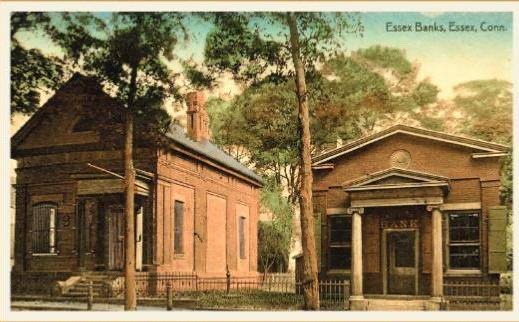
40. 1 Main Street. Built 1880 and housed the Hall’s Store.
41. Essex Square. Shoreline Electric Railroad Company, started service from Old Saybrook in 1910, routed through Essex Main Street, and extended up North Main Street, past the Dickinson Offices. The trolley line extended north and west through Centerbrook, Ivoryton, Deep River, and Chester.

42. The Talbots building and adjacent buildings were once the Benjamin William Jr. Homestead, 1814. Originally there was a small two story house at the top of the old rope walk. In 1925, the Essex Square Theatre was built, to present motion pictures and house offices in the rear.
43. 3 & 5 Essex Square. Miner Block; Samuel Ingersoll Building; Benjamin Williams Jr. House. The two buildings facing the square have housed Essex pharmacy, an Oyster House and other businesses. A large structure for its time, it was built as a store complex in 1835 by Elias Redfield and joint owned by Elias Parmalee in 1842. Albert Miner purchased the business property in 1871, and built an elegant house behind it on Prospect Street. Thus, the commercial structure was known as "Miner's Block," the site of the 1874 oyster house. Miner took on a clerk named Charles Mather, who later became his son-in-law and took over the business as Mather's Store through the early part of the 20th century, specializing in hardware and appliances, later becoming an early home of Essex Hardware. The upper floors of the multi-level structure saw a number of uses come and go, such as a school room, various apartments and for decades, the third floor served as the meeting hall of the local Odd Fellows chapter and the Freemasons.
44. On North Main Street is the Arkin Block, built by Jacob Arkin, 1919, at one time housed a grocery store and other shops.

45. Farnham Parmalee house. 12 North Main Street in Essex, was originally located about 150 feet south of its current location. Built by Farnham Parmelee in 1818, it was purchased by Jacob Arkin in 1919, who moved it to make way for the Arkin Block, a brick commercial building.
46. site of second Ropewalk.

47. After the second ropewalk was destroyed by fire, this commercial building was moved to this location. It has housed several businesses, including a shoemaker, flower shop, and clothing store.
48. Baptist Church Conference Hall, 1837. This building was built just below the brick Baptist House on Prospect Street. When destroyed the local Point school, located where the Essex Savings bank now stands was mysteriously destroyed by a gunpowder explosion, the Baptists sold the building to the Town to house the school in 1845. It operated as a school until 1910. This is now the home of the Essex Art Association.
49. Samuel Lay House. Built in 1754 by Samuel Lay, the son of Robert Lay, Jr., the house at 17 North Main Street in Essex was altered the nineteenth century to conform to the popularity of the Greek Revival style. In 1924, the house was purchased and again altered by E.E. Dickinson, Jr.
50. Smith-Dickinson House. In 1841-1842, Charles Whitmore Smith, a merchant, built a Greek Revival house on North Street in Essex. In 1888, the house was purchased by Edward E. Dickinson, whose E.E. Dickinson Company dominated the nation’s production of witch hazel. The company was started in 1866, when Rev. Thomas Newton Dickinson saw an opportunity to bring the benefits of witch hazel to the general public. Born and raised in New England, Thomas Dickinson understood the powerful healing properties of the native plant, which was used by Native Americans. He opened his first distillery, bottling witch hazel in Essex Village on Prospect Street.
E.E. Dickinson wintered in Florida, where the wealthy community of Palm Beach was being developed at the time. In 1927, Dickinson enlarged and remodeled his house in Essex to resemble Whitehall, Henry Flagler’s famous mansion in Palm Beach. The house was owned by the Dickinson family from 1888 to 1971. It was originally built in the Greek Revival style, with a one story porch wrapping around the front. In 1927, the house was dramatically enlarged. The immediately adjacent Braddock property was demolished to allow for the expansion of the house. The columns were added and garage areas were added.

52. Walcott Pratt Homestead. Opposite the Dickinson Mansion. Once all Lay land, this house was built in 1796, when Wilco’s Pratt married Wolcott Pratt.
53. E.E. Dickinson offices. In 1865, the land and a store located here was purchased by the Dickinson Family. The store was moved to Plains road in 1925, and the current Dickinson Office building was built by E.E. Between 1898 and 1902, the storage (and bottling) building was built by the railroad depot in Centerbrook, and the brick factory on the other side of the tracks was purchased. His son, E. E. Dickinson, Sr., succeeded him, and was responsible for the huge growth of the company. By 1914, there were more than 6,000 barrels of witch hazel stored in Essex. Photos of 1911 show the trolley tracks running past the old office.

54. Next to it are the Dickinson garages, 1925 The family owned much of the land on North Main, including well past the River View cemetery, and including the cemetery itself.
Dickinson Park.
1 note
·
View note